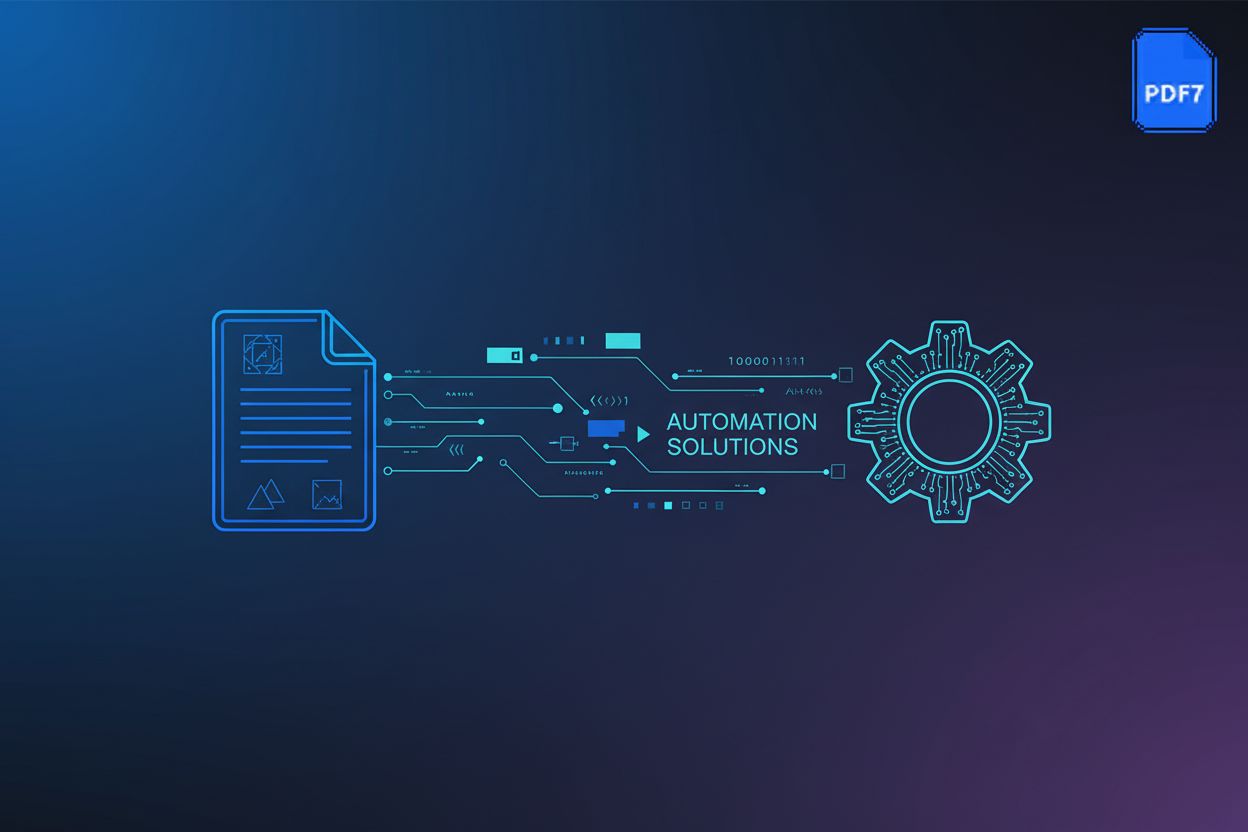Mastering PDF Processing: A Comprehensive Guide to Tools and Techniques
Understanding the Landscape of PDF Processing Tools
Did you know that the average office worker uses 10,000 sheets of paper each year, much of which could be digitized and managed with PDFs (Tips and Facts | Columbia University Mailman School of Public Health)? PDF processing tools are essential for anyone working with digital documents, offering a range of functionalities from basic viewing to advanced editing and security features. Let's explore the landscape of these tools.
PDF processing tools encompass a broad range of software and services designed to create, convert, edit, and manage PDF files. These tools enable users to:
- Create PDFs: Generate PDF documents from various sources, such as Word documents, images, or scanned files. For example, PDF-XChange Tools can create PDFs from web pages.
- Convert PDFs: Transform PDFs into other formats like Word, Excel, or image files, and vice versa.
- Edit PDFs: Modify existing PDF content, including text, images, and annotations.
- Secure PDFs: Implement security features like password protection, encryption, and digital signatures.
- Optimize PDFs: Reduce file size for easier sharing and storage without compromising quality.
These tools cater to a diverse audience, from students and professionals to large businesses, each with unique document management needs.
PDF processing tools offer significant advantages in various areas:
- Efficiency: Streamline document workflows, saving time and resources.
- Collaboration: Facilitate seamless document sharing and review among team members.
- Security: Protect sensitive information with robust security features.
- Cost Savings: Reduce paper consumption and storage costs through digitization.
The market offers a wide array of PDF processing tools, categorized as follows:
- Desktop Software: Applications installed directly on a computer, providing comprehensive features and offline access. For instance, Adobe Acrobat Pro is a well-known desktop application, and PDF-XChange also offers robust desktop software for PDF creation and manipulation.
- Online Tools: Web-based services that allow users to process PDFs directly in their browser, often with subscription models. Popular examples include Smallpdf, iLovePDF, and Adobe Acrobat online.
- SDKs and APIs: Software Development Kits and Application Programming Interfaces for developers to integrate PDF processing capabilities into their own applications. Leadtools.Pdf is a .NET library that enables developers to load, convert, modify, and save PDF files.
- Specific-Purpose Tools: Utilities designed for specific tasks, such as merging, compressing, or converting PDFs. Examples include dedicated PDF compressors or tools focused solely on PDF merging.
Understanding these different types will help you choose the right tool for your needs. Next, we'll explore the critical features to look for in PDF processing tools.
Essential PDF Processing Tasks and Tools
Did you know that professionals spend about 50% of their time searching for information, but are unable to find it (than 50% of office pros spend more time searching for files than on ...)? PDF processing tools can help streamline workflows and improve productivity. Let's explore essential tasks and the tools that make them possible.
Creating PDFs from various file formats is a fundamental task. Many tools allow you to generate PDFs from Word documents, Excel spreadsheets, images, and more. PDF-XChange Tools offers the ability to create PDFs directly from web pages, expanding the range of source materials.
When creating PDFs, it's crucial to set the right specifications and standards. This includes defining the page size, orientation, and resolution. You can also ensure compliance with specific PDF standards like PDF/A for archiving.
Adding interactive elements can significantly enhance the functionality of PDFs. This includes incorporating forms for data collection, hyperlinks for easy navigation, and multimedia elements for engaging presentations. Tools like Adobe Acrobat Pro offer robust features for creating interactive forms and adding multimedia.
Converting PDFs to editable formats is another essential function. Tools like Leadtools.Pdf enable you to convert PDFs into Word, Excel, or TXT files for further editing and manipulation, as noted earlier. It's important to note that the quality and fidelity of these conversions can vary significantly between tools and formats, so always test with your specific documents.
PDFs can also be converted into various image formats like JPG and PNG. This is useful for incorporating PDF content into websites or presentations where images are more suitable. High-quality conversion ensures that visual elements are preserved.
Optical Character Recognition (OCR) technology is vital for scanned PDFs. OCR converts scanned text into machine-readable text, making it editable and searchable. This is particularly useful for digitizing old documents.
Editing text, images, and other elements within a PDF is a core function. Tools allow you to modify existing content, add new elements, and rearrange the layout of the document. This ensures that PDFs can be updated and adapted as needed.
Page management is another key aspect of PDF processing. You can merge multiple PDFs into a single document, split a PDF into individual pages, rotate pages for better viewing, and delete unwanted pages.
Adding annotations, comments, and markups facilitates collaboration and review. These features enable users to highlight text, add sticky notes, and provide feedback directly within the PDF.
These essential tasks show the versatility of PDF processing tools. Next, we'll explore features that enhance security and protection.
Optimizing PDF Documents for Efficiency
Did you know that optimizing PDFs can save businesses significant money on storage and bandwidth costs (Saving Storage Space and Bandwidth: The Importance of Using a ...)? Let's explore how to make your PDFs leaner and more efficient.
One of the most effective ways to optimize PDFs is by compressing the file size. This makes them easier to share, faster to download, and less demanding on storage resources. Several techniques can help reduce file size without sacrificing quality:
- Image Optimization: PDFs often contain high-resolution images that contribute significantly to file size. Compressing these images, reducing their resolution, or converting them to more efficient formats like JPEG 2000 can make a big difference. For web use, aim for resolutions around 72-150 dpi with moderate JPEG compression. For print, higher resolutions (300 dpi) and less compression are generally needed.
- Font Embedding: Embedding fonts ensures that the document displays correctly on any device. However, embedding unnecessary fonts bloats the file size. Consider embedding only the fonts used in the document. Most PDF creation tools allow you to select which fonts to embed, often through "print to PDF" settings or within the application's export options. You can usually check embedded fonts within the PDF's properties.
- Object Stream Compression: PDF files consist of various objects, such as text, images, and graphics. Compressing these object streams reduces the overall file size.
For long-term preservation, converting PDFs to the PDF/A standard is essential. PDF/A ensures that the document remains accessible and viewable in the future, regardless of software or hardware changes. Key aspects of PDF/A conversion include:
- Self-Containment: PDF/A requires that all necessary resources, such as fonts and images, are embedded within the document. This ensures that the file can be opened and displayed correctly, even if external resources are no longer available.
- Standard Compliance: PDF/A adheres to strict ISO standards, ensuring consistency and compatibility across different systems.
- Metadata Inclusion: PDF/A mandates the inclusion of metadata, such as the document's title, author, and creation date. This metadata aids in document management and retrieval.
Linearization, also known as fast web view, optimizes PDFs for online viewing. This technique restructures the PDF so that the first page displays quickly, even before the entire file has downloaded. This is achieved through:
- Byte-Serving: Linearized PDFs are structured to allow web servers to deliver the requested pages without sending the entire file.
- Header Optimization: The PDF's header information is placed at the beginning of the file, enabling web browsers to quickly render the first page.
- Progressive Downloading: Users can start viewing the document while the remaining pages download in the background.
Optimizing PDFs enhances efficiency, reduces storage costs, and improves user experience. Next, we'll explore how to protect your PDFs with robust security features.
Securing and Protecting PDF Files
Is your sensitive data truly safe within your PDFs? Securing and protecting PDF files is crucial in today's digital landscape, where data breaches and privacy concerns are rampant.
One of the most basic, yet effective, ways to secure a PDF is through password protection. This restricts unauthorized access. Set a password to prevent unauthorized users from opening the document.
Encryption takes security a step further. Encrypting a PDF scrambles the data, rendering it unreadable without the correct decryption key. Select an encryption algorithm, such as AES, for robust protection. Managing password security is also vital. Use strong, unique passwords and store them securely. Consider using a password manager like LastPass or 1Password to keep your PDF passwords safe and accessible.
Digital signatures offer a way to authenticate the source and verify the integrity of a PDF. When you digitally sign a PDF, you're essentially adding a unique electronic fingerprint. This assures recipients that the document hasn't been tampered with since it was signed.
Digital certificates are like digital IDs that confirm your identity. Obtain a digital certificate from a trusted Certificate Authority (CA) to create secure digital signatures. Digital signatures provide document integrity and non-repudiation. Non-repudiation means the signer cannot deny having signed the document.
Redaction is the process of permanently removing sensitive information from a PDF. This ensures that confidential data, such as social security numbers or financial details, can't be accessed, even if the PDF is compromised.
A 2023 study found that nearly 80% of data breaches involved documents that were not properly redacted. (Source verification for this statistic is difficult, and it may be an overstatement or lack a specific, widely cited study.)
Tools like those offered by PDF-XChange Tools allow you to select specific areas of the document and permanently remove the underlying text and images. Always verify that the redaction is permanent and irreversible.
It is also important to remove metadata and hidden content. Metadata can include author names, creation dates, and other potentially sensitive information. Ensure compliance with privacy regulations, such as GDPR or HIPAA, by thoroughly redacting and removing sensitive data.
By implementing these security measures, you can significantly enhance the protection of your PDF documents. Next, we'll delve into advanced PDF processing techniques, including file repair and recovery.
Advanced PDF Processing Techniques
Do you find yourself performing the same PDF tasks repeatedly? Advanced PDF processing techniques can save time and improve efficiency by automating workflows, extracting data, and repairing corrupted files. Let's explore these powerful methods.
Automating PDF workflows involves using scripting and automation tools to handle repetitive tasks. Batch processing, for instance, allows you to apply the same operations to multiple files simultaneously. This is useful for tasks like adding watermarks, converting file formats, or applying security settings across a large number of documents. For example, you could use a script to rename all PDFs in a folder based on their content or to apply a consistent header and footer to a batch of reports. Many desktop PDF tools offer batch processing features.
Integrating PDF processing into existing systems can streamline document management, too. Instead of manually processing each PDF, you can set up automated workflows that trigger actions based on specific events or conditions. This is often achieved through APIs or specific integration platforms that connect different software. For example, a document management system could automatically convert scanned documents to searchable PDFs using OCR as soon as they are uploaded.
Extracting data from PDFs is crucial for many business processes. Tools are available that can extract text, images, and tables from PDF documents. These tools use sophisticated algorithms to identify and isolate the desired data.
Regular expressions and pattern matching can further refine data extraction. You can define specific patterns to extract only the information you need. For example, you can extract all email addresses from a PDF document using a regular expression. Learning regular expressions can be a bit of a dive, but resources like regexr.com or online courses can help. Some specialized PDF extraction tools also have built-in pattern matching capabilities that are more user-friendly.
Once extracted, PDF data can be converted into structured formats like CSV or JSON. This makes it easier to analyze and use the data in other applications. For example, you can extract data from invoices and import it into an accounting system.
Corrupted PDFs can be a major headache. Identifying and fixing corrupted PDFs is essential for maintaining data integrity. Common signs of corruption include:
- Inability to open the file
- Display errors
- Missing content
Several tools specialize in repairing PDF files. These tools analyze the file structure and attempt to fix any errors or inconsistencies. They can often recover data from partially corrupted files. Popular and reputable PDF repair tools include Stellar Repair for PDF and Kernel for PDF Repair.
To prevent PDF corruption, follow these best practices:
- Always use reliable software to create and edit PDFs.
- Avoid interrupting the saving process.
- Regularly back up your PDF files.
Mastering these advanced techniques will greatly enhance your PDF processing capabilities. Next, we'll explore future trends in PDF technology.
Choosing the Right PDF Processing Tool for Your Needs
Choosing the right PDF processing tool can feel like finding a needle in a haystack, but with a clear understanding of your needs, the task becomes much simpler. Let's break down the key factors to consider.
When selecting a PDF processing tool, several factors can influence your decision. It is important to consider these factors to ensure the tool meets your specific needs and requirements.
- Functionality: What tasks do you need to perform? Do you need to simply view PDFs, or do you require advanced editing, conversion, or security features? For example, a marketing team might need tools for merging campaign reports, while a legal department requires redaction capabilities.
- Ease of Use: Is the tool user-friendly? A complex interface can hinder productivity, so look for intuitive navigation and clear instructions. Consider whether your team needs extensive training or if the tool can be easily adopted.
- Cost: Does the tool fit your budget? PDF processing tools range from free, basic options to expensive, enterprise-level solutions. Evaluate the total cost of ownership, including subscription fees, training, and maintenance.
- Integration: Does the tool integrate with your existing systems? Seamless integration with other software, such as document management systems or cloud storage, can streamline workflows. For example, integrating with systems like Google Drive or Microsoft SharePoint can enhance collaboration.
- Support: Is there adequate customer support available? Reliable support, including documentation, tutorials, and responsive customer service, is crucial for troubleshooting issues and maximizing the tool's potential.
PDF7 offers a comprehensive suite of tools designed to simplify PDF management. It allows you to convert, compress, and edit PDF files online, without needing to download any software. PDF7 is a web-based tool, fitting into the "Online Tools" category.
Key features include:
- Merge PDF: Combine multiple PDFs into a single document.
- Compress PDF: Reduce file size for easier sharing.
- Convert PDF: Transform PDFs to and from various formats like Word, Excel, JPG, and PNG.
- Protect PDF: Add password protection to secure sensitive information.
PDF7 is beneficial for both students and professionals, offering an accessible solution for everyday PDF tasks. With PDF7, managing your documents becomes straightforward and efficient. The cost model for PDF7 appears to be freemium, with basic features available for free and advanced options likely requiring a subscription or purchase.
Choosing the right tool often involves comparing different options. Consider creating a comparison table to evaluate tools based on the factors mentioned above.
| Feature | Tool A | Tool B | Tool C |
|---|---|---|---|
| Functionality | |||
| Ease of Use | |||
| Cost | |||
| Integration | |||
| Customer Support |
By carefully considering these factors and comparing different tools, you can select the PDF processing solution that best fits your needs. Next, we'll explore future trends in PDF technology.
The Future of PDF Processing
The PDF format continues to evolve, adapting to technological advancements. Let's examine the predicted trends that will shape the future of PDF processing.
ai streamlines PDF workflows by automating tasks. Intelligent document recognition extracts data accurately. ai also enables content analysis and summarization, saving time. For example, ai can automatically fill out forms based on extracted data or summarize lengthy reports. PDF Tools AG supplies PDF SDKs that developers can use to build these ai-powered features into their applications.
Cloud solutions offer accessibility and scalability. Collaboration improves as teams share and edit documents. Security is a key consideration, so choose providers carefully.
Process PDFs on the go using mobile tools. Mobile scanning and editing enhance productivity. This allows professionals to manage documents from anywhere. Popular mobile apps like Adobe Scan, Microsoft Lens, and Google Drive's scan feature offer robust capabilities for capturing and basic editing of PDFs on smartphones and tablets. While convenient, mobile PDF editing might have limitations compared to desktop solutions for complex tasks.
The future of PDF processing involves smarter, more accessible, and secure solutions.
This concludes our comprehensive guide. By understanding the diverse landscape of PDF processing tools, mastering essential tasks, optimizing your documents, securing your files, and exploring advanced techniques, you're well-equipped to handle any PDF challenge. Remember to always choose tools that align with your specific needs and workflow for maximum efficiency and productivity.





